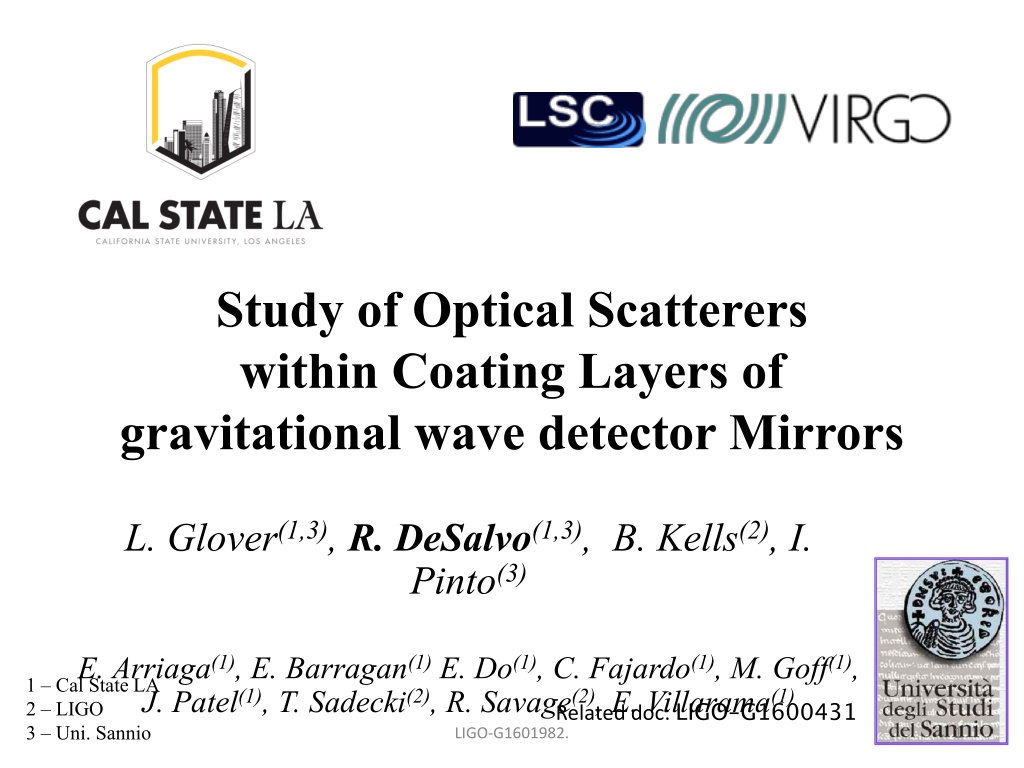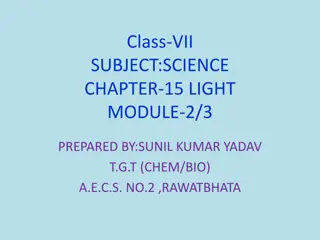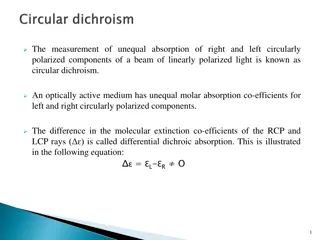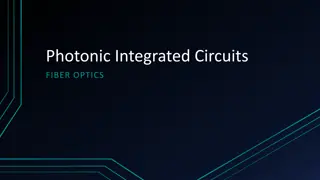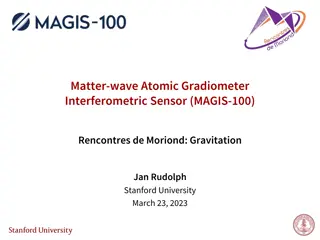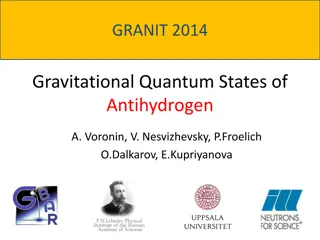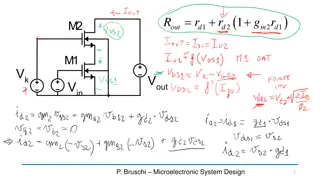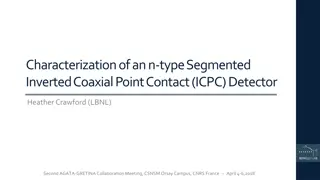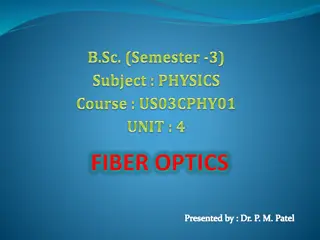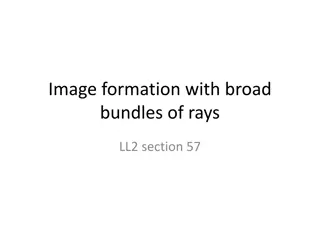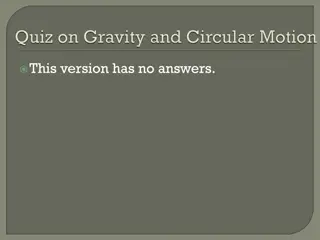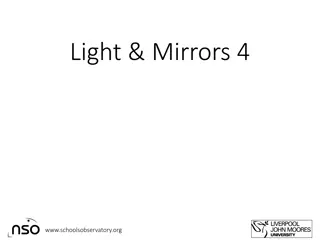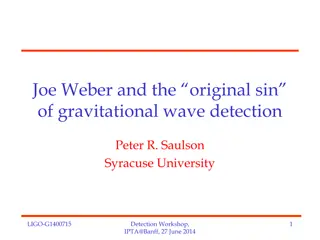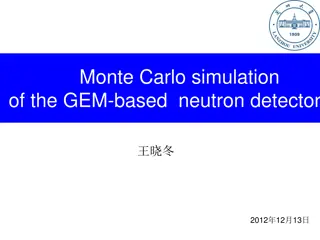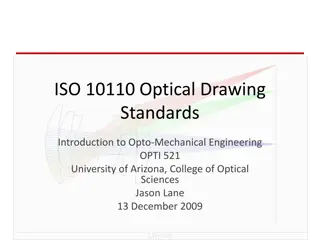Study of Optical Scatterers Within Coating Layers of Gravitational Wave Detector Mirrors
Analyzing scattering points within Advanced LIGO mirror coatings revealed unexpected weak scatterers, potentially influencing energy losses and thermal noise in gravitational wave detectors. Individual scatterers were identified using DAOPHOT, an algorithm originally created for astronomy, to pinpoint and extract these anomalies. The study sheds light on the critical impact of scatterers in coating layers on the performance of gravitational wave detectors.
Uploaded on Oct 08, 2024 | 0 Views
Download Presentation

Please find below an Image/Link to download the presentation.
The content on the website is provided AS IS for your information and personal use only. It may not be sold, licensed, or shared on other websites without obtaining consent from the author. Download presentation by click this link. If you encounter any issues during the download, it is possible that the publisher has removed the file from their server.
E N D
Presentation Transcript
Study of Optical Scatterers within Coating Layers of gravitational wave detector Mirrors L. Glover(1,3), R. DeSalvo(1,3), B. Kells(2), I. Pinto(3) E. Arriaga(1), E. Barragan(1)E. Do(1), C. Fajardo(1), M. Goff(1), J. Patel(1), T. Sadecki(2), R. Savage(2), E. Villarama(1) 2 LIGO 3 Uni. Sannio 1 Cal State LA Related doc: LIGO-G1600431 LIGO-G1601982. 1
Gravitational Wave detectors mirror thermal noise Dielectric coatings on mirrors present an anomalously low quality factor 104-105 as compared to >109 for Q-factor for the fused silica substrate. This dissipation is responsible for most of the thermal noise of mirrors of all gravitational wave detectors. Mechanical dissipation in coatings is the single most important limit for the detection range of Gravitational waves Nobody knows where these losses reside or come from. LIGO-G1601982. 2
Brief Summary We analyzed scattering points in photos of Advanced LIGO mirror illuminated by 100 kW stored beams Hundreds of thousands of progressively weaker scatterers were observed where few were expected, likely extending through the depths of the coating layer stack Probable locus of the energy losses LIGO-G1601982. 3
Method Individual scatterers were identified using DAOPHOT an astronomer s algorithm to identify stars in galaxies 1. Extract apparent amplitude and position of each scatterer 2. Subtract the identified stars and iterate LIGO-G1601982. 4
Daophot Mechanism: Point Spread Templates A point spread template is created from selected sources within the image. Then it is used to search scatterers Point Spread Template for an exposure time of 1.25 x 10-4 s LIGO-G1601982. 5
Daophot Mechanism: Problems CCD dynamic range LIGO-G1601982. 6
Daophot subtraction effectiveness Pixel amplitude histogram of original Image 200 100 Most pixels restored to dark pixel Residual pixel amplitude histogram after scatterer extraction Residual pixel distribution within 2-3 pixels FWHM Mostly from saturation effects -50 50 LIGO-G1601982. 7
Identifying/subtracting scatterers Subtracted Photo Original Photo Fluffy dirt ignored 256 100 expanded pixel scale Dark pixels 256 dots mark the place where scatterers have been excised dirt does not fit template is ignored by daophot and masks out real weaker scatteres LIGO-G1601982. 8
Number of Scatterers vs. Exposure Time Exposure @ 0.125 ms @ 1 ms exposure @ 400 ms exposure Scatterers (1st Run) 76 624 127,774 100,000 10,000 Scatterer count plateaus due to saturation. 1,000 100 Number increases almost linearly with exposure Exploring weaker and weaker scatterers Deeper and deeper in the dielectric coating layers ! ! LIGO-G1601982. 9
Apparent size: Depth in stack effect There are two depth attenuation components: 1. Attenuation of impinging light due to reflections through depth of coating layers 2. Back-reflection on front layers attenuates Scattered light Image: Stuart Reid, Iain Martin, 2016 Scattered light detected by CCD Back reflected scattered light LIGO-G1601982. 10
Scatterer light intensity distribution @ Exposure Time = 0.0125 sec The rapid slope of reconstructed scatterers at low amplitude is compatible with what expected from the reflection curve. 6000 3000 Integrated CCD count LIGO-G1601982. 11
How many scatterers are actually there ? Drop of laser light impedes detection of scatterers below first 2-3 layers 26 layers in each HR coating ~200 scatterers /mm2 LIGO-G1601982. 12
Origin of scatterers Virtually no absorption (<0.25 ppm) Positive or negative density (n) fluctuations Positive = crystallites, in glasses catalyze crystallization Negative = large fluctuation of natural voids in glasses Both have dangling bonds, i.e. double well potentials adsorbing mechanical energy LIGO-G1601982. 13
Ongoing work Two steps proposed: 1. Sum coherently lower exposure images from LIGO to mitigate saturation. 2. Study ad-LIGO witness samples to determine scatterer s depth distribution through layers and size distribution LIGO-G1601982. 14
Lucky byproduct Study of image to image star position motion for coherent addition of images yielded a metod to independently detect: Motion of stored beam within mirror Motion of mirror w.r.t. camera. LIGO-G1601982. 15
DAOPHOT position resolution Differential star position between two images The scatter of the points (standard deviation) = ~11 m positioning error of daophot Calibration 1Pixel = ~80 m LIGO-G1601982. 16
Detection of mirror motion Mirror motion Mirror position resolution ~ 1.3 m Calibration 1Pixel = ~80 m LIGO-G1601982. 17
Depth scatterer exploration Study a spare witness samples to determine the scatterer s depth distribution the scatterer s size distribution LIGO-G1601982. 18
X, Y Axis micropositioning CCD Camera Z Axis piezo focusing White light LED 50% Reflector @ 45 1 3 2 Microscope lens AdLIGO Multi-Layered Mirror LIGO-G1601982. 19
Grid scan of Mirror X1 X2 Xn Raster scan X-Y of microscope frames on mirror surface to identify rough scatterer position Y1 Y2 Defocused Scatterers Yn LIGO-G1601982. 20
Potential depth resolution Depth of field 0.6 m / n depth resolution of ~ 30 nm/ n achieved from Z-scan Wide angle-white light illumination allow penetration of many layers Focused Scatterer Defocused Scatterer Defocused Scatterer Maximum Luminosity +Z -Z LIGO-G1601982. 21
Conclusions 1 A very large population of scatterers was found on aLIGO mirrors under high-power illumination. They contribute to large angle optical scattering, if the observed points are the locus of mechanical dissipation, they may explain the anomalous mechanical dissipation observed in sputtered coatings. The discovery is a good diagnostic tool, perhaps indicating possible ways to reduce the Sensitivity limitation for Gravitational Wave detectors LIGO-G1601982. 22
Conclusions 2 Methods are being developed to monitor 1. mirror to camera and 2. beam to mirror micro-movements Both can be valuable diagnostic tools at the observatory LIGO-G1601982. 23
